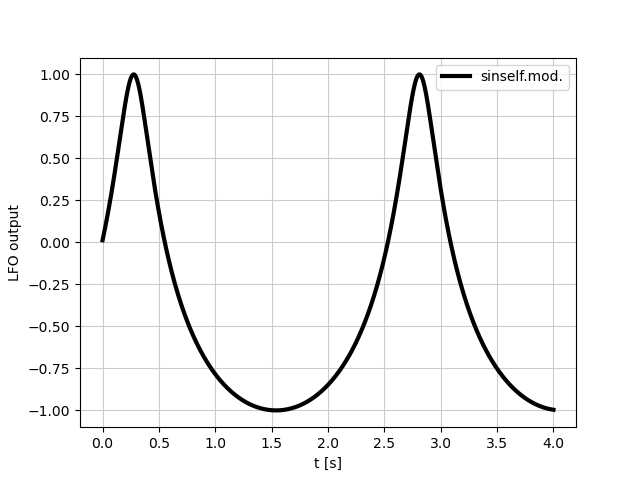If you modulate RATEMathematically, LFO can be described as a function of aninternal phase of the oscillator
 where func represents the oscillator function, e.g. sine, square, triangle, sawtooth, etc.
where func represents the oscillator function, e.g. sine, square, triangle, sawtooth, etc.
The phase increases in time at a given rate:
 where r is the rate.
where r is the rate.
With LFO withmodulating its own rate, the outputrate can be expressed as:
 where r₀ is the base rate setting on the LFO, and m is the modulation depth, or more likely as:
where r₀ is the base rate setting on the LFO, and m is the modulation depth, or more likely as:
 as to me exponential modulation seems more logical for this parameter.
The whole equation for LFO then becomes:
as to me exponential modulation seems more logical for this parameter.
The whole equation for LFO then becomes:
![LFO=func(integral(r0·exp[m·LFO(phi(t))]dt)](https://i.sstatic.net/ykUYQCk0.png) So indeed there is a self-reference of that LFO in the equation, it couldwhich might be expressedconfusing. Mathematicians don't solve this type of equations by calling the following schematicfunction over and over, but rather by smartly guessing a function (in this case: LFO(t)) which would solve the equation. If you want to learn more mathoverflow is probably a good site.
So indeed there is a self-reference of that LFO in the equation, it couldwhich might be expressedconfusing. Mathematicians don't solve this type of equations by calling the following schematicfunction over and over, but rather by smartly guessing a function (in this case: LFO(t)) which would solve the equation. If you want to learn more mathoverflow is probably a good site.
A digital synthesizer solves this equation numerically, with an algorithm that could be schematically presented as:
for each time step:
phase += rate * dt
lfo_output = lfo_functionfunc(phase % 360°)
rate = rate_setting +* exp( modulation_depth * lfo_output )
where lfo_function represents the shape of the lfo (sinenote, trianglethis is not a state of the art algorithm to solve numerical equations, custom...but rather a simple way to present the idea).
I cannot provideWhile finding the functional representation of the LFO.output might be difficult, I guess it requires solvingcan provide some integral to take into accountintuition:
- the function will be periodic
- the lower parts of the LFO function will become wider and the upper ones thinner (or the other way round for negative modulation)
- for symmetric initial LFO shape and bipolar modulation, the effective rate will decrease, because stretching the lower parts by some factor, and squeezing the top parts by the same factor results in overall stretching of the waveform
Below I present the shape of LFOeffect on several common oscillator shapes. In all cases, thebase rate settingr₀ = 0.5 Hz (period 2s) and modulation depth. I would expect the function to be always periodic m = 1, with the period depending on these three factorsexponential modulation (Eqs. This implies4 and 5). Notice how the upper and lower parts of the waveform are deformed differently, and how the effective rate you setchanges differently depending on the LFOwaveform shape (base rate without modulation) will not be the actual ratein particular compare square wave with the modulationothers).













![LFO=func(integral(r0·exp[m·LFO(phi(t))]dt)](https://i.sstatic.net/ykUYQCk0.png)







